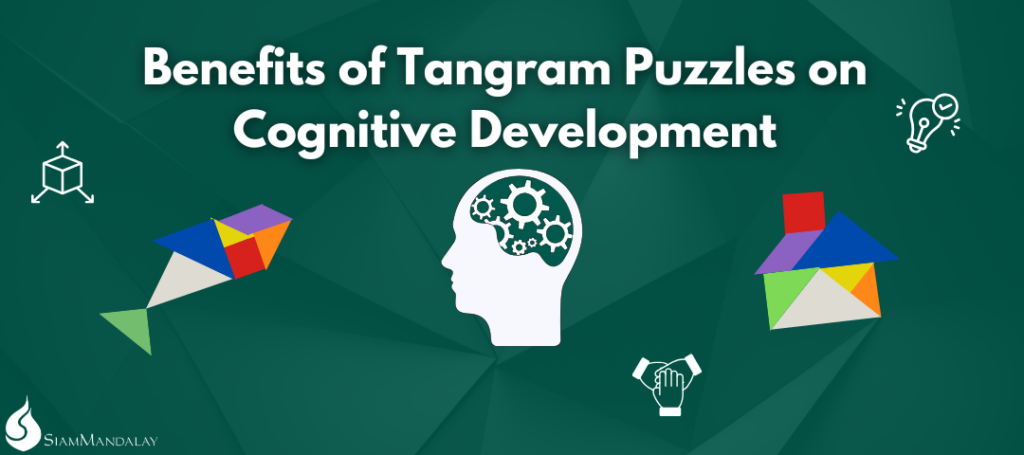
Introduction
Tangram puzzles are unique on account of the opportunity they provide to exercise skills that are otherwise difficult to practice. They offer the chance to practice problem solving, spatial reasoning/awareness, math concepts, perceptual reasoning and more. It even allows for the use of parts of the brain that otherwise lie dormant when solving problems without a visual or spatial element to them. All these components together serve the vital purpose of developing cognitive skills within children. Skills that remain important throughout the rest of their education and life.
What is a Tangram Puzzle?
Tangram puzzles are comprised of seven geometric shapes that serve as pieces to a whole. When combined the seven pieces make up a larger picture, typically a square. Although, these pieces can also be used to create several other shapes, patterns, and images. Cognitive development can be improved while working with tangrams both individually, and in a group or classroom setting. Although still beneficial when used digitally, tangram puzzles offer the most benefits when the pieces are tangible, and physically handled by the user.
Cognitive Developmental Benefits
Visuospatial Awareness: Tangram puzzles allow children to invoke the visual-spatial aspects of their intelligence. The nature of a tangram puzzle requires an understanding of space. Knowing how all the smaller shapes fit into a given space in order to construct the bigger picture.
Tactile Ability: Not only is visual-spatial awareness on full display during tangram puzzles, but tactile and touch ability as well. Children who work with tangible tangram puzzles, especially at younger ages, become more familiar with the physical objects they manipulate. Enabling more exploratory and out-of-the-box thinking as opposed to when tangrams or other puzzles are done digitally.
Geometry Skills: Simply exploring tangrams and attempting solutions aid in several aspects of geometric understanding. When assembling a tangram, concepts of congruency, symmetry, area, perimeter, as well as supplementary and complementary angles are all key factors. Whether or not they are identified and called out by name is not as important, but at the very least, the concepts are being broadly introduced. Children come to sharpen their understanding of shapes in space, and what they mean in relation to each other.
Creativity: Thinking independently and putting one’s creative mind to use is difficult to accomplish outside of a strictly creative setting like the arts. However, when it comes to tangram puzzles, there is a level of creativity required to find the solution. tangram puzzles often entail lots of trial and error, which at a certain point begins to feel repetitive. Continuing to introduce new ideas and new potential solutions is necessary for the puzzler to continue. Teaching creativity and imagination in the process.
Problem Solving: As mentioned before, there is lots of trial and error involved in solving tangram puzzles. Yet there is still significant thought and consideration between attempts. Problem solving ability gets worked on incrementally between each of these steps. It forces the user to take a step back and assess what worked, what did not, and how to proceed. Which offers the unique chance for children and students to practice solving spatial problems. Studies have also indicated that successful problem solvers with tangram puzzles search the available space more widely for solutions than unsuccessful puzzlers. Doing well with tangrams entails keeping an open mind and entertaining many potential options, in hopes of leading to the solution.
Brain Activation: Geometric problem solving has been shown to lead to increased brain activity in the right hemisphere of the brain, as well as the prefrontal cortex. Further, when the puzzlers failed to find the solution to the tangram, brain activity was measured even higher than during successful attempts. This is all to say that engaging with executive planning and other visual/spatial reasoning problems kicks certain parts of the brain into action as it searches for the solution. Parts that are only activated when dealing with tangram style spatial reasoning puzzles.
Conclusions
Practicing with and solving tangram puzzles offer opportunities for engaging with spatial and logical reasoning problems. Chances to interact with these ideas as children are not very common, which makes the time spent on them and the lessons learned all the more valuable. Introducing these kinds of concepts like tactile ability, geometry, problem solving, and creativity at a young age can help to set up a child with the chance to hone their soft skills as they grow. They can become more receptive to advancing their skills in the future, with the confidence that a baseline understanding provides. A baseline that can be achieved through practice with spatial, problem-solving oriented brainteasers and puzzles like the tangram.
References
Ayaz, et al. (2012). Tangram solved? Prefrontal cortex activation analysis during geometric problem solving. San Diego, CA, USA.34th International Conference of the IEEE EMBS. https://www.biopac.com/wp-content/uploads/Tangram_Geometry_fNIRS.pdf
Yoshiki, Nakano. (2017). Cognitive and Attentional Process in Insight Problem Solving of the puzzle game “Tangram”. Cognitive Science
